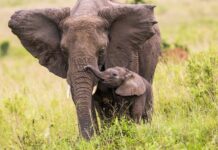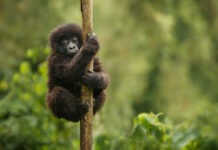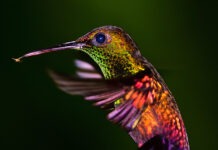Illegal trade continues as species disappear and exotic diseases fill doctors with a new fear.
In 2009, the U.S. Fisheries and Wildlife Department reported 140,984 total wildlife shipments, comprised of 146,734 mammals, 940,349 reptiles, 3,291,807 amphibians, 181,908 birds and 165,198,128 fish. Recent conservation news has highlighted disappearing numbers of threatened amphibians. The North American bullfrog, whose legs are sold as a culinary item is an example of the toxic potential of such exotic trade, linked with the spread of an amphibian fungal disease caused by the fungus Batrachochytrium dendrobatidis or Bd. In the U.S.
A pilot study that is part of Wildlife Conservation Society’s “One World One Health” initiative began tracking samples of wildlife and wildlife products transported through main entry points in 2008. As of April 2010, researchers had uncovered at least 14 species, including rodents, monkeys and apes. In chimpanzees and mangabeys imported for food—known as bush meat—there was evidence of two strains of simian foamy virus. The primates are both endangered and illegal to import. And simian foamy virus is a retrovirus is in the same family of diseases as HIV, the retrovirus that causes AIDS.
These virus can infect humans but are not yet know to cause disease. But it is generally known that HIV rose through human contact with nonhuman primates, says Nina Marano, veterinarian in the CDC’s quarantine branch. Just like HIV it may be able to infect people before they become sick, she says. “We want people to know that taking meat from the wild is bad for animals and bad for humans,” Marano says.
Wildlife trade has proven difficult to regulate—particularly because its regulation crosses several federal agencies. “There are gaps in regulation,” says FWS Senior Wildlife Inspector Sheila Einsweiler. “There are a host of wildlife with no quarantine and there is always potential for another monkeypox situation,” she adds.
EcoHealth Alliance is working to broaden the scientific knowledge base when it comes to identifying species and the pathogens they carry. But data recording is flawed, shipment numbers are inaccurate and current laws fail to keep tabs on the diversity of wildlife imported. “We are kind of stuck and don’t have much analysis of the myriad of diversity,” says Kate Smith, PhD, a researcher with the Alliance.
Peter Daszak, PhD, is president of EcoHealth Alliance and has worked for years on collaborative projects that have evolved into modern conservation medicine efforts, including the amphibian decline and the impact of the West Nile virus. The field has grown substantially in the last 20 years. Studies now show where new diseases are most likely to emerge and can trace some viruses and pathogens to wildlife trade. But there is still work to be done.
“We don’t screen for SARS [severe acute respiratory syndrome caused by a pathogen in mammals and birds] or monkeypox, and those are spread through trade,” he says.
Any proposed policy faces a powerful pet industry, Daszak says. The trick is finding a compromise. “People who want to keep pets can do so without destroying the environment or spreading disease,” he says.
Ultimately, the biggest risks are the ones no one can predict. Animals that are not tracked to the species level make the creating of databases impossible.
Awareness only comes after an incident like the monkeypox outbreak when authorities are forced to react to unknown circumstances. This however presents an unpredictable challenge that could invariably cost lives. In combating the threat a level of responsibility, caution and undoubtedly common sense needs to be administered by the public as does the allocation of resources and research to the respective authorities monitoring wildlife trade and diseases.
Source: EcoHealth Alliance / Emagazine

















